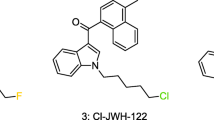In the present study we analyze the synthesis as well as biotransformation pathways and metabolic stability of 4-fluoro- N -(1-{2-[2-(methylsulfanyl)phenoxy]ethyl}pyrrolidin-3-yl) benzene sulfonamide – thioether compound 5, with the affinity for several subtypes of the serotonin and dopamine receptor. Studies were conducted in vitro on liver microsomes from three species – mouse, rat, and human. The biotransformation was analyzed using liquid chromatography coupled with mass spectrometry. Two major metabolites (M1 and M2) – products of S-oxidation of the parent molecule – were generated both by in silico and in vitro methods. Use of three species allowed us to determine the interspecies differences in metabolic stability of tested compound. Two parameters, t0.5 and Clint , were calculated. Compound 5 was the most stable in human liver microsomes. Results are useful for understanding the interspecies differences in metabolism of the serotonin and dopamine receptor ligand associated with sulfur atom.







Similar content being viewed by others
References
H. Ishibashi, M. Nakamura, A. Komori, et al., Semin. Immunopathol ., 31(3), 399 – 409 (2009).
P. Zajdel, R. Kurczab, K. Grychowska, et al., Eur. J. Med. Chem ., 56, 348 – 360 (2012).
K. Grychowska, K. Marciniec, V. Canale, et al.,Arch. Pharm. (Weinheim ), 346(3), 180 – 188 (2013).
P. B. Hedlund, Psychopharmacology (Berl .), 206(3), 345 – 354 (2009).
C. Ecker, W. Spooren, and D. Murphy, J. Intern. Med ., 274(4), 308 – 320 (2013).
K. A. Scott and J. T. Njardarson, Top. Curr. Chem ., 376(1), 5 (2018).
P. Kubowicz, H. Marona, and E. Pêkala, Chirality , 27(2), 163 – 169 (2015).
E. Pekala, P. Kubowicz, and D. Lazewska, Appl. Biochem. Biotechnol ., 168(6), 1584 – 1593 (2012).
C. Leoni, F. M. Buratti, and E. Testai, Toxicol. Appl. Pharmacol ., 233(2), 343 – 352 (2008).
R. S. Obach, Drug Metab. Dispos ., 27(11), 1350 – 1359 (1999).
J. N. Bauman, J. M. Kelly, S. Tripathy, et al., Chem. Res. Toxicol ., 22(2), 332 – 340 (2009).
K. S3oczyñska, K. Wójcik-Pszczo3a, V. Canale, et al., J Biochem. Mol. Toxicol ., 32(5), e22048 (2018).
K. Piska, A. Galanty, P. Koczurkiewicz, et al., Food Chem. Toxicol ., 120, 112 – 118 (2018).
ACKNOWLEDGMENTS
This work was supported by Jagiellonian University Medical College (Grant No. N42/DBS/000101). The authors are indebted to ChemAxon Ltd. for access to Metabolizer software.
CONFLICT OF INTEREST
The authors declare no conflict of interest. The authors alone are responsible for the content and writing of the paper.
Author information
Authors and Affiliations
Corresponding author
Rights and permissions
About this article
Cite this article
Kubowicz-Kwaoeny, P., Piska, K., Klaoe, K. et al. Synthesis, in Silico and in Vitro Study on Phase I Metabolism of the Potent 5-Ht7/5-Ht1a/D2 Receptor Ligand: 4-Fluoron -(1-{2-[2-(Methylsulfanyl)- Phenoxy]Ethyl}Pyrrolidin-3-Yl) Benzene Sulfonamide. Pharm Chem J 53, 713–719 (2019). https://doi.org/10.1007/s11094-019-02068-y
Received:
Published:
Issue Date:
DOI: https://doi.org/10.1007/s11094-019-02068-y




